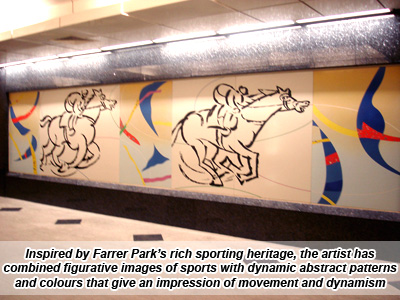|

Farrer Park station

Farrer Park boasts a rich
heritage for sports, and is well known as a breeding ground
for soccer talents. Home to a horse racing track in the
1800s, the area even
housed Singapore's first golf club in later years.
Located under Race Course
Road, Farrer Park station has eight entrances, making it the
station with the most entrances on the North East Line. Some
of these
entrances serve a newly built HDB estate at Farrer Park.
Four other entrances were designed to integrate with future
developments above and around the
station.
The area around the
station is peppered with buildings of varying vintage, with
some buildings laying claim to a century old history. The
age of the buildings, coupled
with soft ground conditions, tested the engineers'
tunnelling and technical expertise during the construction
of the station. The new Farrer Park station brings a new
lease of life to this historical area.
Back To Top
Farrer Park was a focal
point for all who were passionate about sports. Regarded as
the birthplace of Singapore soccer, crowds have roared over
goals on Farrer
Park's soccer pitches from the pre-war years through to the
1970s. The Park's swimming pool, tennis courts and athletic
track stadium introduced generations of
school children to the exciting rough and tumble of sports.
Poh Siew Wah himself has
many happy memories of swimming and watching sports games at
Farrer Park during his school days. Combining research with
these
memories of his boyhood, Poh Siew Wah has created a
collection of works celebrating Farrer Park's rich sporting
traditions for Farrer Park station.
The artist uses images of
sporting, dance and body movements in his works; working
with curvilinear shapes and swirling lines to keep the image
basic, graceful and
light.
What makes his works
distinctive is his simultaneous use of both the figurative
and abstract forms. His artworks, executed in silkscreen on
vitreous enamel, comprise
enlarged expressive brush drawings of sportsmen and dancers
in black on white background panels. These drawings are
alternated with coloured panels of abstract
shapes and lines depicting body movements teeming with a
sense of energy and celebration.

Back To Top
Four sets of vitreous
enamel panels depicting swimming and other games like
hockey, soccer, athletics, gymnastics and dance are located
at the different subway
entrances on the concourse level. A fifth set of
panels
which depicts horse racing reminds commuters that
Singapore's very first turf club was established in Farrer
Park.
Special efforts were made
by the artist and architects at Farrer Park station to match
the drawings of various sports to the entrance closest to
the exact location
where that sport was originally played. In this way,
commuters entering Farrer Park station at the "soccer"
entrance, for example, have the pleasure of walking on
ground that saw the birth of Singapore soccer.
The dilemma that
confronted the artist was how to marry abstracts, his
preferred art form, with something that would make an
instant connection with time-strapped
commuters. His solution was to use both figurative and
abstract elements as the basis for the entire design.

Back To Top
The combination of the
figurative and the abstract also stretched the artist's
resources, pushing him to draw on his vast experience as an
artist and an art teacher
while reflecting the sensibilities of his more recent works.
While the artworks
showcase two different art forms, common threads run through
the abstract and the realistic creating a single, seamless
whole. Both the abstract
and the realistic works speak the language of movement and
rhythm. When a person moves, say, by running across a soccer
field, he leaves a trace of a line. This
sense of movement starts in the brush strokes then draws the
eye into the abstract work so that the lines and shapes
extend from the realistic to the abstract and
back again; creating fluid, flowing movements that have a
sense of harmony.

At the same time, there
are enough differences between each abstract-realistic pair
to create interest and contrast; a sense of the "yin
and yang"
within the whole if you like.
To create his expressive
brush drawings, the artist crumpled the paper he used
beforehand to create jagged edges and uneven textures.
To create the sense of
energy in his drawings, the artist worked with a Chinese
brush, using his whole arm to create the shapes in the one
quick movement. With the
abstracts, he worked with coloured paper, cutting out the
shapes to create precise sharp lines and better definition.

Back To Top
In his works for Farrer
Park station, the artist also demonstrates the effective use
of colour. While the brush drawings are in black against a
white panel, the
abstracts are in pastel shades. Pastels were chosen to
suffuse the station with a light, soothing ambience. These
colours were then tonally gradated to create depth
and a feeling of spaciousness.
In the finished artwork,
Poh Siew Wah's acute colour sense and his mastery of
movement in the realistic and the abstract forms give Farrer
Park station its distinctive
identity.
Artist:
Poh Siew Wah
Born: Singapore, 1948
Education:
- Self-taught artist
- Specialist Art Education Course, 1979
Institute of Education, Singapore
next: Boon Keng station
Back To Top
|